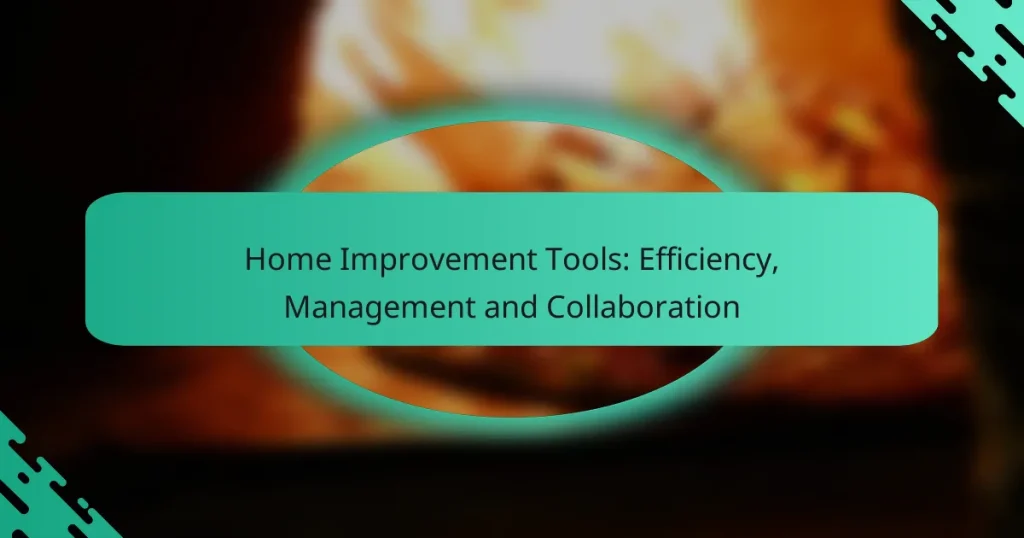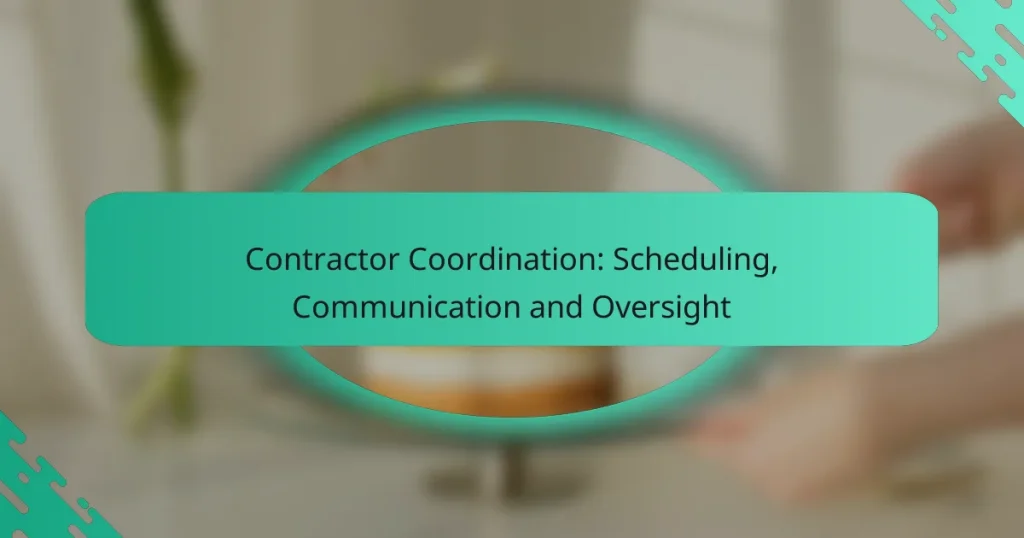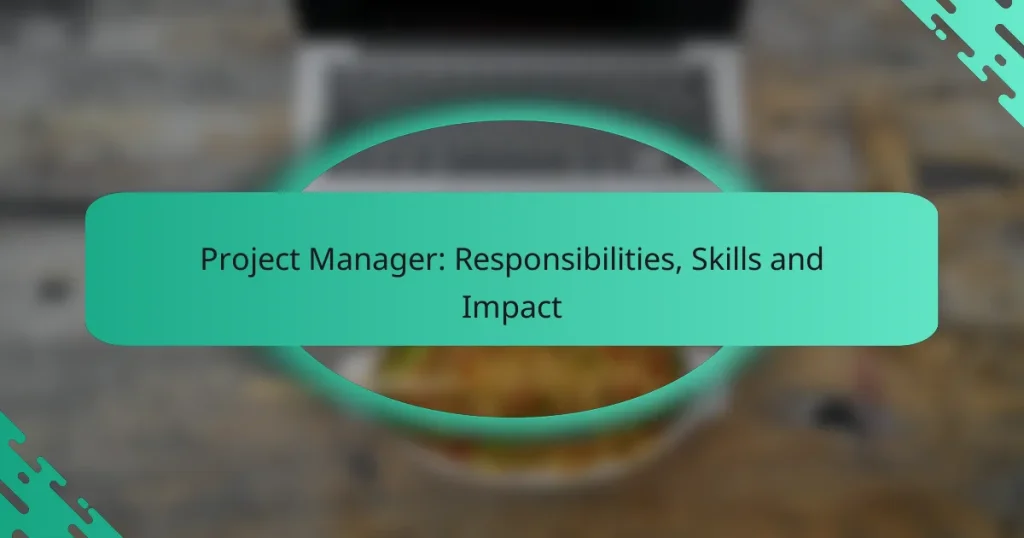Managing home improvement projects requires meticulous planning and execution to ensure compliance with local regulations and budget constraints. By defining the project scope, establishing a timeline, and hiring qualified contractors, homeowners can navigate the complexities of renovation effectively. Implementing best practices such as clear communication and regular inspections further enhances the likelihood of a successful outcome.
Clear Communication: Strategies, Benefits and Tools
Home Improvement Tools: Efficiency, Management and Collaboration
Contractor Coordination: Scheduling, Communication and Oversight
Home Renovation Timeline: Planning, Milestones and Deadlines
Project Manager: Responsibilities, Skills and Impact
Home Improvement Budgeting: Unexpected Costs, Planning and Strategies
How to manage home improvement projects in Los Angeles?
Managing home improvement projects in Los Angeles involves careful planning and execution to ensure that the project meets local regulations and stays within budget. Key steps include defining the project scope, setting a budget, establishing a timeline, hiring local contractors, and obtaining necessary permits.
Define project scope
Defining the project scope is crucial as it outlines what work will be done and sets clear expectations. Start by identifying the specific improvements you want to make, such as kitchen renovations or landscaping changes.
Consider the size and complexity of the project. A well-defined scope helps prevent scope creep, which can lead to increased costs and delays. Document your goals and requirements to keep all stakeholders aligned.
Set a budget
Setting a budget is essential for managing home improvement projects effectively. Begin by estimating costs for materials, labor, and any additional expenses such as permits or inspections.
In Los Angeles, home improvement projects can range significantly in cost. For example, a kitchen remodel might start from a few thousand dollars and go up to tens of thousands, depending on the extent of the work. Always include a contingency of about 10-20% for unexpected expenses.
Establish a timeline
Establishing a timeline helps keep the project on track and ensures timely completion. Break down the project into phases, such as planning, demolition, and construction, and assign realistic timeframes to each phase.
Consider potential delays due to weather or contractor availability, especially in a busy market like Los Angeles. A clear timeline allows you to monitor progress and make adjustments as needed.
Hire local contractors
Hiring local contractors is beneficial as they are familiar with Los Angeles building codes and regulations. Research and interview multiple contractors to find one that fits your project needs and budget.
Check references and reviews to ensure quality work. Local contractors may also have established relationships with suppliers, which can lead to better pricing on materials.
Obtain necessary permits
Obtaining necessary permits is a critical step in managing home improvement projects in Los Angeles. Many projects, especially structural changes, require permits from the city to ensure compliance with local building codes.
Visit the Los Angeles Department of Building and Safety website to learn about specific permit requirements for your project. Failing to secure the proper permits can result in fines and complications during the project.
What are the best practices for home improvement project management?
The best practices for home improvement project management include clear communication, thorough documentation, and regular site inspections. These strategies help ensure projects stay on schedule, within budget, and meet quality standards.
Regular communication with contractors
Maintaining regular communication with contractors is essential for successful project management. Schedule weekly check-ins to discuss progress, address concerns, and make necessary adjustments. This proactive approach minimizes misunderstandings and keeps everyone aligned on project goals.
Utilize various communication tools, such as emails, messaging apps, or project management software, to facilitate ongoing dialogue. Ensure that all parties have access to the same information to avoid confusion and delays.
Document progress and changes
Documenting progress and changes throughout the project is crucial for tracking milestones and managing expectations. Keep a detailed log of work completed, materials used, and any modifications to the original plan. This documentation serves as a reference for future discussions and can help resolve disputes.
Consider using photographs to visually document the project’s evolution. This not only provides a clear record but also helps in assessing quality and compliance with design specifications.
Conduct site inspections
Conducting regular site inspections is vital for ensuring that work is progressing as planned and meeting quality standards. Schedule inspections at key milestones, such as the completion of major phases, to evaluate workmanship and adherence to safety regulations.
During inspections, check for compliance with local building codes and regulations. Address any issues immediately to prevent costly rework and delays. Keeping a checklist can help ensure all critical aspects are reviewed during each visit.
How to select the right contractors for home improvement?
Selecting the right contractors for home improvement is crucial for ensuring quality work and a smooth project experience. Focus on their reputation, qualifications, and pricing to make an informed decision.
Check references and reviews
Start by asking potential contractors for references from previous clients. Contact these references to inquire about their experiences, focusing on the quality of work, timeliness, and communication.
Additionally, check online reviews on platforms like Google, Yelp, or specialized home improvement sites. Look for patterns in feedback, such as consistent praise or recurring complaints, to gauge the contractor’s reliability.
Verify licenses and insurance
Ensure that the contractors you consider have the necessary licenses to operate legally in your area. This may include general contractor licenses or specialized certifications depending on the work scope.
Confirm that they carry adequate insurance, including liability and workers’ compensation. This protects you from potential financial liability in case of accidents or damages during the project.
Compare quotes
Request detailed quotes from multiple contractors to understand the cost breakdown. Look for clarity in pricing, including labor, materials, and any additional fees.
While comparing, consider not just the total cost but also the scope of work included. The cheapest option may not always provide the best value, so weigh quality against price carefully.
What are common challenges in home improvement project management?
Home improvement project management often faces several challenges that can hinder progress and increase costs. Key issues include budget overruns, delays in timelines, and quality control problems, all of which require careful planning and proactive management to mitigate.
Budget overruns
Budget overruns occur when the actual costs of a project exceed the planned budget. This can happen due to unexpected expenses, changes in project scope, or inaccurate initial estimates. To avoid this, set a realistic budget that includes a contingency of around 10-20% for unforeseen costs.
Regularly review expenses against the budget throughout the project. Consider using project management software to track spending in real-time, which can help identify potential overruns early. Communicate openly with contractors about costs to prevent surprises.
Delays in timelines
Delays in timelines can significantly impact home improvement projects, often leading to increased costs and frustration. Common causes include weather conditions, supply chain issues, and labor shortages. To minimize delays, create a detailed project schedule with clear milestones and deadlines.
Build in buffer time for each phase of the project to accommodate potential setbacks. Regularly check in with contractors and suppliers to ensure that timelines are being met, and adjust plans as necessary to keep the project on track.
Quality control issues
Quality control issues arise when the work completed does not meet the expected standards or specifications. This can lead to costly rework and dissatisfaction with the final results. To ensure quality, establish clear standards and expectations from the outset and communicate them to all team members.
Conduct regular inspections throughout the project to catch any issues early. Consider hiring a third-party inspector for an unbiased assessment, especially for critical phases like electrical or plumbing work. Document any quality concerns and address them immediately to maintain project integrity.
What tools can assist in home improvement project management?
Effective home improvement project management can be greatly enhanced by utilizing various tools designed for organization, budgeting, and scheduling. These tools streamline processes, improve communication, and help keep projects on track.
Project management software
Project management software is essential for planning and tracking home improvement projects. These platforms allow users to create task lists, assign responsibilities, and monitor progress in real-time. Popular options include Trello, Asana, and Microsoft Project, which cater to different project sizes and complexities.
When selecting project management software, consider features like collaboration tools, file sharing, and integration with other applications. A user-friendly interface can also enhance team engagement and productivity.
Budget tracking apps
Budget tracking apps help homeowners manage expenses throughout their improvement projects. These applications allow users to set budgets, track spending, and categorize costs, ensuring that financial resources are allocated efficiently. Examples include Mint, YNAB (You Need A Budget), and HomeZada.
To effectively use budget tracking apps, regularly update your expenses and review your budget against actual spending. This practice can help identify areas where costs can be reduced or where additional funds may be needed.
Scheduling tools
Scheduling tools are crucial for coordinating timelines and ensuring that all tasks are completed on time. These tools can help create project timelines, set deadlines, and manage dependencies between tasks. Google Calendar and Microsoft Outlook are commonly used for scheduling, while specialized tools like GanttPRO offer more detailed project visualization.
When using scheduling tools, be sure to account for potential delays and build in buffer time for unforeseen issues. Regularly updating your schedule can help keep the project on track and ensure that all team members are aware of their responsibilities and deadlines.
What are the local regulations for home improvement in California?
In California, home improvement regulations are primarily governed by local building codes, zoning laws, and state laws. Homeowners must obtain the necessary permits for most construction projects, ensuring compliance with safety and environmental standards.
Understanding Building Permits
Building permits are essential for any significant home improvement project in California. These permits ensure that the work meets local safety codes and zoning regulations. Common projects requiring permits include additions, major renovations, and electrical or plumbing work.
To obtain a permit, homeowners typically need to submit detailed plans and specifications to their local building department. Fees for permits can vary widely based on project size and complexity, often ranging from a few hundred to several thousand dollars.
Zoning Regulations
Zoning regulations dictate how properties can be used and what types of improvements are allowed. In California, these regulations can affect setbacks, height restrictions, and land use. Homeowners should check local zoning laws before starting any project to avoid potential legal issues.
For example, if a homeowner wants to build a garage, they must ensure it complies with local zoning requirements regarding its location on the property. Violating zoning laws can lead to fines or the need to remove the structure.
Environmental Considerations
California has strict environmental regulations that may impact home improvement projects, particularly those that affect natural resources. Homeowners must consider regulations related to water conservation, energy efficiency, and the protection of endangered species.
For instance, projects in certain areas may require an environmental impact report (EIR) if they could significantly affect the environment. Homeowners should consult with local authorities to understand any environmental assessments needed for their projects.






